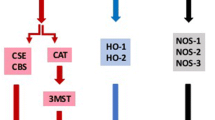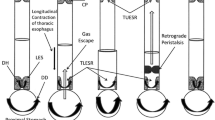Abstract
The lining of the stomach of man is protected from its unique secretion, hydrochloric acid, by a variety of highly specialized characteristics. Foremost is its relative impermeability to hydrogen ions. The gastric surface epithelial cell which forms a continuous integument from the esophagus to the duodenum plays an important role in this barrier function. Disruption of the barrier by injurious agents, sepsis, or shock may lead to severe erosive gastritis when acid is present within the lumen of the stomach. This process is accelerated during periods of low mucosal blood flow. The relationship of the rate of back-diffusion of hydrogen ions to mucosal blood flow appears critical. Factors which (a) inhibit acid secretion, (b) strengthen the barrier to H+ diffusion, or (c) increase mucosal blood flow will protect the stomach from injury. Prostaglandins of the A, E, and F series offer a level of protection in experimental erosive gastritis that is out of proportion to their effect on acid secretion and mucosal perfusion. The secretion or filtration of an alkaline secretion may be an important component of the cytoprotection which follows the topical exposure of gastric mucosa to 16,16-dimethyl (PGE2). The role of mucus release in this situation requires further elucidation.
Résumé
La paroi gastrique de l'homme est protégée contre sa propre sécrétion, l'acide chlorhydrique par plusieurs mécanismes hautement spécialisés. Le plus important est l'imperméabilité relative de la muqueuse aux ions hydrogènes. Les cellules de l'épithélium de surface, qui tapissent en une couche continue tout l'estomac depuis l'oesophage jusqu'au duodénum, jouent un rôle important dans la fonction de cette barrière muqueuse. Toute rupture de la barrière, par des agents délétères, par une infection ou par un état de choc, peut provoquer, si le contenu gastrique est acide, l'apparition d'une gastrite érosive grave. Le développement des lésions est accéléré par toute réduction du débit sanguin dans la muqueuse. La relation entre rétrodiffusion des ions hydrogènes et débit sanguin muqueux semble être un facteur critique. Les facteurs qui (1) inhibent la sécrétion d'acide, (2) renforcent la barrière à la diffusion des ions H+, (3) accroissent le débit sanguin dans la muqueuse, protègent l'estomac contre le développement des lésions. Dans des conditions expérimentales, les prostaglandines de types A, E et F protègent contre la gastrite érosive; cette protection est sans rapport avec leurs effets sur la sécrétion d'acide et la perfusion de la muqueuse. La sécrétion ou la filtration d'une composante alcaline est peut-être un facteur important de la cytoprotection que donne le 16, 16-diméthyl (PGE 2) en application locale. Le rôle du mucus dans ces circonstances est encore mal connu.
Similar content being viewed by others
References
Robert, A.: Antisecretory, antiulcer, cytoprotective and diarrheogenic properties of prostaglandins. In Advances in Prostaglandin and Thromboxane Research, Samuelsson, B., Paoletti, R., editors, New York, Raven Press, 1976, vol. 2, pp. 507–520
Davenport, H.W.: Fluid produced by the gastric mucosa during damage by acetic and salicylic acids. Gastroenterology50:487, 1966
Menguy, B., Masters, Y.F.: Mechanism of stress ulcer. Gastroenterology66:1168, 1974
Takeuchi, K., Johnson, L.R.: Pentagastrin protects against stress ulceration in rats. Gastroenterology76:327, 1979
Levine, B.A., Sirinek, K.R.: Splanchnectomy protects gastric mucosal blood flow during hypovolemic shock in the miniature swine model. Gastroenterology78:1206, 1980
Zalewsky, C.A., Moody, F.G.: Mechanisms of mucus release in exposed canine gastric mucosa. Gastroenterology77:719, 1979
Zalewsky, C.A., Moody, F.G.: Ultrastructural analysis of mucus secretion in human gastric mucosa. Fed. Proc.39:768 (Abst. 2640) 1980
Moody, F.G., Durbin, R.P.: Effects of glycine and other instillates on concentration of gastric acid. Am. J. Physiol.209:122, 1965
McGreevy, J.M., Moody, F.G., Zalewsky, C.: Effects of topical 16,16-dimethyl prostaglandin E2 on aspirin ulcerogenesis. Surg. Forum29:413, 1978
Moody, F.G., Simons, M., Jackson, T.: Effect of pchloramercuribenzene sulfonate on gastric parietal and surface cell function in the dog. Gastroenterology68:279, 1975
Simons, M.A., Moody, F.G., Torma, M.J.: Effects of carbenoxolone on gastric mucosal permeability and blood flow in the dog. Gastroenterology71:603, 1976
Moody, F.G., Aldrete, J.S.: Hydrogen permeability of canine gastric secretory epithelium during formation of acute superficial erosions. Surgery70:154, 1971
Silen, W.: New concepts of gastric mucosal barrier. Am. J. Surg.133:8, 1977
Larsen, K.R., Davis, E.K., Moody, F.G.: A proposed mechanism of acid-bile shock ulcerogenesis. Fed. Proc.39:326, 1980
Cheung, L.Y., Chang, N.: The role of gastric mucosal blood flow and H+ back-diffusion in the pathogenesis of acute gastric erosions. J. Surg. Res.22:357, 1977
Hamza, K.N., DenBesten, L.: Bile salts producing stress ulcers during experimental shock. Surgery77:161, 1972
Ritchie, W.P.: Acute gastric mucosal damage induced by bile salts, acid, and ischemia. Gastroenterology68:699, 1975
Moody, F.G., McGreevy, J.M., Zalewsky, C., Cheung, L.Y., Simons, M.: The cytoprotective effect of mucosal blood flow in experimental erosive gastritis. In Gastric Ion Transport, Proceedings of a Symposium on Gastric Ion Transport in Uppsala, Sweden, July 24–28, 1977, Öbrink, K.J., Flemström, G., editors, Uppsala, University of Uppsala, 1978, p. 35
Cheung, L.Y., Toenjes, A.: Influence of gastric mucosal blood flow in the ability of gastric mucosa to maintain its intramural pH. Gastroenterology78:1149, 1980
Kivilaakso, E., Silen, W.: Pathogenesis of experimental gastric-mucosal injury. N. Engl. J. Med.301:364, 1979
McGreevy, J.M., Moody, F.G.: A mechanism for prostaglandin cytoprotection. Br. J. Surg. (in press)
Priebe, H.J., Skillman, J.J., Bushnell, L.S., Long, P.C., Silen, W.: Antacid versus cimetidine in preventing acute gastrointestinal bleeding. N. Engl. J. Med.302:426, 1980
Guth, P.H., Aures, D., Paulsen, G.: Topical aspirin plus HCl gastric lesions in the rat, cytoprotective effect of prostaglandin, cimetidine, and probanthine. Gastroenterology76:88, 1979
Menguy, R., Desbaillets, L., Masters, Y.F.: Mechanism of stress ulcer: influence of hypovolemic shock on energy metabolism in the gastric mucosa. Gastroenterology66:46, 1974
Mullane, J.F., Pyant, R.L., Jr., Wilfong, R.G., Dailey, W.: Starvation, glucose, and stress ulcers in the rat. Arch. Surg.109:416, 1974
Kivilaakso, E., Kalima, T.V., Lempinen, M.: Modification of porcine stress ulceration by methylprednisolone, vitamin A and methysergide treatment. Eur. Surg. Res.,8:281, 1976
Hoffmann, P., Schwille, P.O., Samberger, N.M., Schellerer, W.: [Calcium in the prevention of stress ulcer in the rat.] Langenbecks Arch. Chir. 1976 suppl.:228, 1976
Robert, A., Nezamis, J.E., Lancaster, C., Hanchar, A.J.: Cytoprotection by prostaglandins in rats. Prevention of gastric necrosis produced by alcohol, HCl, NaOH, hypertonic NaCl, and thermal injury. Gastroenterology77:433, 1979
Konturek, S.J., Bowman, J., Lancaster, C., Hanchar, A.J., Robert, A.: Cytoprotection of the canine gastric mucosa by prostacyclin: possible mediation by increased mucosal blood flow. Gastroenterology76:1173, 1979
Cheung, L.Y., Jubiz, W., Torma, M.J., Frailey, J.: Effects of aspirin on canine gastric prostaglandin output and mucosal permeability. Surg. Forum25:407, 1974
Miller, T.A.: Progress report: gastrointestinal cytoprotection by prostaglandins. Gut20:75, 1979
Bolton, J.P., Palmer, D., Cohen, M.M.: Stimulation of mucus and nonparietal cell secretion by the E2 prostaglandins. Dig. Dis. Sci.23:359, 1978
Chaudhury, T.K., Jacobson, E.D.: Prostaglandin cytoprotection of gastric mucosa. Gastroenterology74:59, 1978
Schiessel, R., Matthews, J., Barzilai, A., Merhav, A., Silen, W.: PGE2 stimulates gastric chloride transport: possible key to cytoprotection. Nature283:671, 1980
Archibald, L.H., Moody, F.G., Simons, M.A.: Comparison of gastric mucosal blood flow as determined by aminopyrine clearance and gamma-labeled microspheres. Gastroenterology69:630, 1975
Cheung, L.Y.: Comparison of gastric mucosal blood flow measured by14C aminopyrine clearance and radioactive microspheres during 16,16-dimethyl prostaglandin E2 inhibition of acid secretion. In The Measurement of Splanchnic Blood Flow, Granger, N., Bulkley, G.B., editors, Baltimore, Williams and Wilkins Co., 1981, chapter 8
Barzilai, A., Bartzokis, G., Kivilaakso, E., Silen, W.: Failure of cytoprotection 16,16-dimethyl prostaglandin E2 (16-16D) in amphibian gastric mucosa. Gastroenterology76:1095, 1979
Whittle, B.J.R.: Mechanisms underlying gastric mucosal damage induced by indomethacin and bile, salts, and the actions of prostaglandins. Br. J. Pharmacol.60:455, 1977
Lindt, S., Baggiolini, M.: Effect of a PGE2 analogue (PG-E′2) on the vascularization of the gastric mucosa in the rat. Experientia32:802, 1976
Guth, PH., Code, C.F.: Histamine release and gastric mucosal damage. Gastroenterology74:622, 1978
Rees, W.D.W., Rhodes, J., Wheeler, M.H., Meek, E.M., Newcombe, R.G.: The role of histamine receptors in the pathophysiology of gastric mucosal damage. Gastroenterology72:67, 1977
Cheung, L.Y., Porterfield, G.: Is histamine a mediator of bile-induced gastric mucosal injury. J. Surg. Res.24:272, 1978
Author information
Authors and Affiliations
Additional information
Supported by NIH Grant #5 R01 AM 16233-10.
Rights and permissions
About this article
Cite this article
Moody, F.G., Zalewsky, C.A. & Larsen, K.R. Cytoprotection of the gastric epithelium. World J. Surg. 5, 153–163 (1981). https://doi.org/10.1007/BF01658278
Issue Date:
DOI: https://doi.org/10.1007/BF01658278




